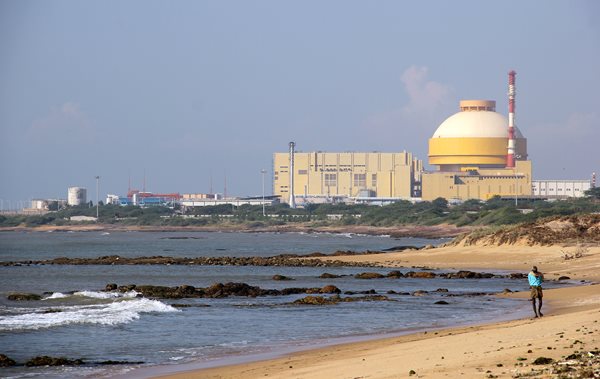

Kudankulam nuclear power plant, one of India's newest
India will soon have 12 more nuclear plants to improve the power situation and ensure there is a free flow of uninterrupted power supply for both industries and residential use, a statement issued by Secretary of the Department of Atomic Energy (DAE), K N Vyas said.
“Nuclear technology helps in betterment of lives through varied usages and is an irreplaceable source of clean, pollution-free energy,” the statement quoted Vyas, who is also the Atomic Energy Commission of India’s Chairman, as saying at the 11th International Forum AtomExpo 2019, sponsored by Rosatom State Atomic Energy Corporation, held in Sochi, Russia, recently.
Read:Nuclear Energy Has A New Fan in Bill Gates. Will Perceptions Change?
He said the founder of Indian nuclear programme, Homi J. Bhabha, had envisaged that nuclear technology is going to be “very essential” and not just in the power sector but for other societal uses intended for betterment of life.
[related_post]
“We believe that when it comes to clean energy, there is no substitute to nuclear energy as it is sustainable and without interruption, one can have clean energy,” the statement said citing the Secretary’s remarks.
Citing the record run of Kaiga Nuclear Power Station, he said a small unit of indigenously-developed 220-250MW reaction has completed 962 days of uninterrupted run at about 99.3 percent capacity and the amount of electricity it has generated is “tremendous”.
Vyas said the first stage of India’s indigenous nuclear power programme has now attained maturity with 18 operating Pressurised Heavy Water Reactors (PHWRs).
The AtomExpo was held in Sochi with the slogan ‘Nuclear for better life’, with over 3,600 participants from 74 countries in attendance, including new ones like Qatar, Bahrain and Nicaragua.
Read also: Report Urges using Nuclear Energy for Clean Energy Ecosystem in US
“Peaceful atom is associated with all aims and goals fo the UN Sustainable Development Program. The Forum became a space for discussing the latest technologies thus ensuring a base for the future of the planet,” said Rosatom State Corporation Director-General Alexey Likhachev. Vyas added that the government of Prime Minister Narendra Modi has sanctioned 10 PHWRs in fleet mode, besides plans afoot for constructing two light water reactors.
Due to earlier trade bans and lack of indigenous uranium, India has uniquely been developing a nuclear fuel cycle to exploit its reserves of thorium. The Indian government wants to grow its nuclear power capacity to plug the holes in its power supply and high transmission loss which stands close 16%-27% of the total generation. By 2032, the government plan to install capacity of 700 GWe to meet 7-9% GDP growth, with 63 GWe nuclear. At the start of 2018, six reactors were under construction in India, with a combined capacity of 4.4 GWe. The OECD’s International Energy Agency predicts that India will need some $1.6 trillion investment in power generation, transmission and distribution to 2035. In March 2018, the government stated that nuclear capacity would fall well short of its 63 GWe target and that the total nuclear capacity is likely to be about 22.5 GWe by the year 2031.
Nuclear technology is however not only intended to generate power. It is also useful for doctors and scientists and offers huge improvement in technological innovations in the medical field for cancer patients undergoing radiotherapy. The move to go nuclear of course faces multiple obstacles, not the least of which is public perception of risks associated with it. That has been visible in the huge NIMBY( Not in my backyard) protests witnessed against the Jaitapur station in Maharashtra as well as against Kudankulam in Tamil Nadu. Environment agencies, who have been dead against nuclear power could however, be hardpressed to justify their resistance as energy needs in India continue to grow, and the choice falls between coal and nuclear, especially if the global warming predictions continue to come true .
Picture credit: World Nuclear Association
1. The mandate for blending Compressed Biogas (CBG) with natural gas has come into effect…
Andhra Pradesh is striving towards greening its energy sector with quite some speed. In a…
With an objective to bolster India’s green energy goals, a Tripartite Agreement has been signed…
The Union MNRE Minister Pralhad Joshi launched the Green Hydrogen Certification Scheme of India (GHCI)…
India’s energy conglomerate Bharat Petroleum Corporation Limited (BPCL) has commissioned a 5MW green hydrogen plant…
In a historical development, the European Space Agency (ESA) has successfully launched its pioneering ‘Biomass’…